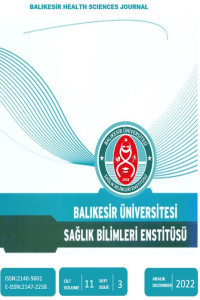ACİL SERVİSTEN KENDİ İSTEĞİYLE AYRILAN HASTALARIN ANALİZİ
AMAÇ: Tüm uyarılara rağmen acil servisten ayrılmak isteyen hastalar geriye dönük olarak incelendive özellikle hastaların acil serviste kalma süreleri değerlendirilmesi amaçlandı.
YÖNTEM: Aralık 2012 – Mart 2013 tarihleri arasında devlet hastanesi acil servisine gelen ve muayene, tetkik ve gözlem aşamalarının herhangi bir kısmında, kendisine her türlü tıbbi risk ve ihtimaller anlatılmasına rağmen imza atarak hastaneden ayrılan hastalar geriye dönük olarak incelendi. Sayısal değişkenler ortalama±Standart deviasyon (Minimum değer, Maksimum değer) Median değer olarak belirtildi. Kategorik değişkenler sayı ve yüzde olarak sonuçlandırıldı. BULGULAR: Beş aylık dönemde hastanemiz acil servisinden, tüm tıbbi risklerin açıklanmasına rağmen kendi isteğiyle hastaneden yarılan 18 yaş ve üzeri 52 bayan (% 58,43) ve 37 erkek (% 41,57) olmak üzere toplam 89 hasta dâhil edildi. 89 hastanın 10’u (%11,20) başka bir merkeze gitmek istedi, 16 hasta (% 17,98) ise hastaneye yatması önerilmesine rağmen yatış yapmayı kabul etmedi. 63 hasta ise (%70,82) acil serviste tanı, tedavi ve takibi kabul etmemiş ve acil servisten ayrılmıştır. Hastaların tamamının acil serviste kalış süreleri ortalama olarak 163,65±135,2 (Min: 6 Max: 698) dakika idi. İntoksikasyon, karın ağrısı ve göğüs ağrısı ile takip edilen hastalar ortalama süreden fazla takip edilmişken travma nedeniyle acil servise gelen hastaların acil serviste bekleme süreleri daha az olmuştur. Hastaların hastaneye geliş saatine göre de hastanede kaldıkları toplam süreleri değişmekte ve saat 21 den sonra gelen hastalar daha uzun süre hastanede kalmış ve sonrasında ayrılmıştır
SONUÇ: Acil servislerden ayrılmak isteyen hastaların o anda neden ayrılmak istedikleri özenle sorgulanmalı ve acil servislerin mevcut imkânları, hekimlerin tecrübeleri doğrultusunda hastanın sorunları değerlendirilerek çözüm önerileri geliştirilmelidir.
Anahtar Kelimeler:
Acil Servis, Ayrılma, Reddetme, Tedavi
ANALYSIS OF PATIENTS LEAVING THE EMERGENCY DEPARTMENT ON THEIR OWN WILL
INTRODUCTION: Patients who desired leaving the emergency department despite all warnings have been retrospectively analyzed and an attempt to evaluate patient’s length of stay at the emergency ward was aimed.
METHODS: Patients who arrived to the emergency ward of the state hospital between the dates of December 2012 – March 2013 and who left the hospital by giving their signature at any of the examination, analysis and observation phases despite being told of all the medical risks and probabilities were studies retrospectively. Numeric variables were indicated as average ± Standard deviation (Minimum value, Maximum value) Median value. Categorical variables were concluded in numbers and percentages.
RESULTS: A total of 89 patient being 52 female ( 58,43 %) and 37 (41,57 %) male patients left the emergency ward of the hospital despite all medical risks being explained to them were included. The total duration of the stay of all the patients was in average 163,65±135,2 (Min: 6 Max: 698) minutes. While patients monitored for intoxication, stomachache and chest pain were followed-up for period longer than the average period, the length of stay of patients arriving to the emergency department due to traumas has been less.
DISCUSSION AND CONCLUSION: The patients’ motive for leaving the emergency department at that time must be questioned with care and solution proposals must be developed by evaluating the patient’s issue in line with the experience of the doctors and existing availabilities at the emergency wards.
Keywords:
Emergency department, Leaving, Refusal, Treatment,
___
- 1. Ersoy N, Senses MÖ, Er RA. Informedconsent in emergencymedicine. Ulus Travma Acil Cerrahi Derg 2010;16 (1):1-8
- 2. Johnson M, Myers S, Wineholt J, et al. Patients who leave the emergency department without being seen. J EmergNurs 2009;35:105-8
- 3. Serinken M, Turkcuer İ, Ozen M, et al. A Retrospective Analysis of Patients who Visited the Emergency Department and Left by Their Own Choice in a University Hospital. JAEM 2013;12:126-9
- 4. Guneysel O, Onur OE, Sarıtemur M, et al. Muayene Edildikten Sonra Tıbbi Uyarılara Rağmen Acil Servisi Terk Eden Hastaların Değerlendirilmesi.Turk J EmergMed 2008;8:79-83.
- 5. Bambi S, Scarlini D, Becattini G, et al. Characteristics of patients who leave the ED triage area without being seenby a doctor: a descriptive study in an urban level II Italian University Hospital. J EmergNurs 2011; 37: 334-40
- 6. Chan TC, Killeen JP, Kelly D, et al. Impact of rapid entry and acceleratedcare at triage on reducing emergency department patient wait times, lengths of stay, and rate of left without being seen. AnnEmergMed 2005;46:491-7.
- 7. Debehnke D, Decker MC. The effects of a physician nurse patient care team on patientsatisfaction in an academic ED. Am J Emerg Med 2002;20:267-70.
- 8. Bruce TA, Bowman JM, Brown ST. Factors that influence patient satisfaction in the emergency department. J NursCareQual 1998;13:31-7
- 9. Bulut H. The effects of informing patients and their relatives on satisfaction at emergency units. Ulus Travma Acil Cerrahi Derg 2006;12(4):288-298
- 10. Özen M, Serinken M, Yılmaz A, et al. Socio demographic and Clinical Features of Patients Diagnosed with Acute Coronary Syndrome Consulting to the Emergency Department. Tr J EmergMed 2012;12(3):117-122
- 11. Yılmaz Ö. Acute myocardial infarction with ST-elevation. J ExpClinMed 2012; 29:123-25
- 12. Jaffe, A.S.,Ravkilde, J., Roberts, R., et al., It’s time for a change to a troponin standard. Circulation. 2000;102:1216-20.
- 13. Göksu S, Yıldırım C, Kocaoğlu H, et al. Characteristics of acute adult poisoning in Gaziantep, Turkey. J ToxicolClinToxicol 2002;40:833-7.
- 14. Yılmaz A, Güven FM, Korkmaz İ, et al. Retrospective Analysis of Acute Poisonings in the Emergency Department. C. Ü. Tıp Fakültesi Dergisi 2006;28(1):21-26,
- 15. Satar S, Seydaoglu G, Akpinar A, et al. Trends in acute adult poisoning in a ten-yearperiod in Turkey: factors affecting the hazardous outcome. BratislLekListy 2009;110:404-11
- 16. Dal O, Kavak H, Akay S, et al. Retrospective evaluation of poisoning patients in the emergency department. Journal of ContemporaryMedicine 2013;3(1):22-27
- ISSN: 2146-9601
- Yayın Aralığı: Yılda 3 Sayı
- Başlangıç: 2012
- Yayıncı: Balıkesir Üniversitesi
Sayıdaki Diğer Makaleler
ACİL SERVİSTEN KENDİ İSTEĞİYLE AYRILAN HASTALARIN ANALİZİ
Mesude MURT ATLI, Mustafa YILMAZ, Fatih Nazmi YAMAN, Sinem KABUL, Mehmet YÜZÜGÜLLÜ
Elif DİRİMEŞE, Fatma Demir DEMİR KORKMAZ, Aliye OKGÜN ALCAN
Burak GÜLCEN, Emrah ÖZCAN, Murat Abdulgani KUŞ, Ömür KARACA SAYGILI, Dilara KAMAN, Murat ÖGETÜRK, İlter KUŞ
REHABİLİTASYON HEMŞİRELİĞİNDE HAYVAN DESTEKLİ UYGULAMALAR
